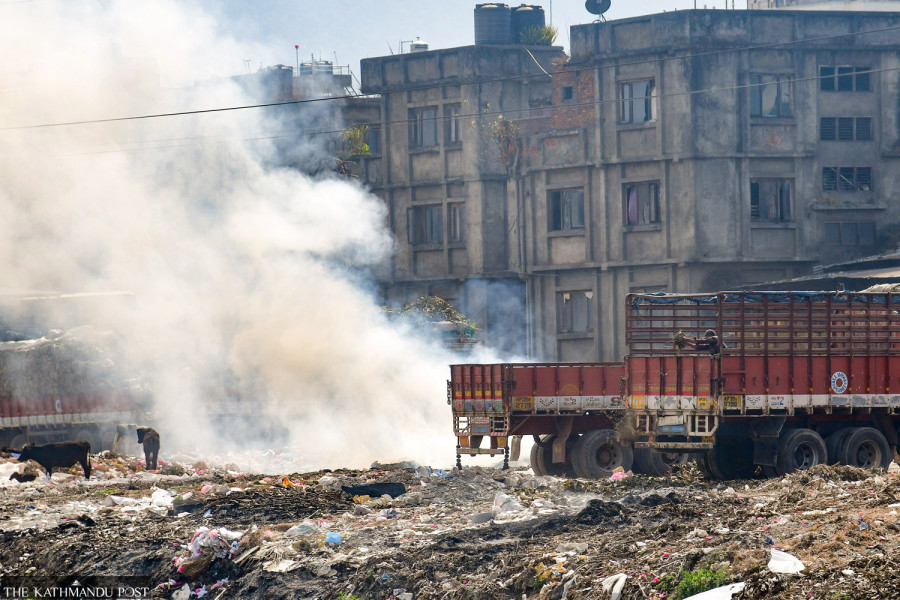Climate & Environment
Forest fires and open burning activities cause haze in Kathmandu Valley
As people started burning household waste due to a halt in garbage collection, experts warn the worst is yet to come.
Arjun Poudel
Haze covered the Kathmandu Valley throughout the day on Tuesday, as open burning activities and incidents of forest fire across the country have increased air pollution many folds of late.
Lack of rainfall for a long time has been blamed for the worsening air quality in the Valley, which reached unhealthy levels on Tuesday afternoon.
Meteorologists say that there was a chance of light precipitation in some places of Province-1, Bagmati Province and Gandaki Province on Tuesday, and Lumbini Province could see light rain on Wednesday, but that too will not bring significant relief as there is no system in place currently to cause heavy rainfall or strong wind to blow away pollutants in the air.
“The haze in Kathmandu Valley has been caused by pollutants,” said Pratibha Manandhar, a senior meteorologist at the Meteorological Forecasting Division under the Department of Hydrology and Meteorology. “Due to lack of sufficient rainfall and heavy winds, air pollution has increased in Kathmandu Valley.”
The division said that no system has developed so far to cause heavy rainfall or strong wind in the next 72 hours.
This year, air quality of Kathmandu Valley has not yet reached hazardous levels so far, but environmentalists say that the worst is yet to come as incidents of open burning and forest fire have just started.
“Farmers burn the residue of their crops in this season, and incidents of forest fire have started rising throughout the country,” said Bhupendra Das, an air quality and clean energy specialist. “Many other factors—emissions from brick kilns, factories, vehicular movements and construction activities among others, which contribute to the deterioration of air quality, have been going on in full swing.”
People also started burning household waste in Kathmandu Valley, due to a halt in the collection of the garbage by local authorities for several weeks.
“Gray sky in this season is an indicator of rise in particulate matter in the air,” said Das. “As authorities concerned are not doing substantial to improve the air quality level, we can expect the worst situation like last year.”
Pollution level had worsened in this season last year too. Authorities concerned had issued a red alert and enforced schools closure for four days on March 29 last year to lessen adverse effects of rising air pollution on students’ health.
IQAir, a Swiss group that collects air-quality data from around the world, ranked Nepal among the top 10 countries, having the worst air quality in 2021.
On Tuesday, Kathmandu Valley’s air quality index reached 152. As per the United States Environment Protection Agency’s air quality index, when air pollutant PM2.5 reaches 151 to 200 μg/m3, air quality is considered unhealthy; everyone may experience problems, with sensitive groups feeling more severe effects. When it exceeds 300 μg/m3, it is considered “hazardous” for everyone and may prompt emergency condition alerts.
The dry condition, caused by lack of rainfall, has increased incidents of forest fires of late. Forests are burning across the country.
Recent infrared satellite images from NASA’s FIRMS (Fire Information for Resource Management System) showed at least 225 fire incidents from east to west of the country.
Doctors say poor air quality causes short- and long-term effects on public health. Bad air quality can cause pneumonia, bronchitis, conjunctivitis, skin allergy, stroke and heart problems, among others, in the short term, and ulcers and cancer of the lungs and intestine, kidney disease and heart problems in the long-run.
Experts say that due to apathy of the authorities in enforcing measures to improve the air quality, people are bearing the brunt. The government had introduced Kathmandu Valley Air Quality Management Plan in 2020 with the aim to lessen air pollution of the Valley, but lack of effective implementation of the plan has failed to meet expectations.
“There are several ways with which air quality can be improved,” said Bhusan Tuladhar, an environmentalist. “Launching awareness drives against the hazards of open burning, making waste management effective, prohibiting burning of waste in the open, encouraging people to work from home and restricting unnecessary vehicular movement can help improve the air quality.”




 8.12°C Kathmandu
8.12°C Kathmandu










